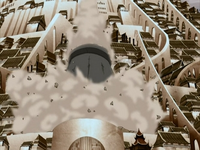| "Fighting the Fire Nation is the only path to freedom. And freedom is worth dying for." |
| — Yung to Avatar Aang.[1] |
The earthbender rebellions[2] were a series of armed uprisings against the Fire Nation occupation of the Earth Kingdom, occurring during the later stages of the Hundred Year War. However, despite the conflict's name, the very mass of the rebels were nonbenders who were led by earthbenders. The first known rebellions in occupied territory occurred in winter 99 AG, but they became widespread some time after the Coup of Ba Sing Se in 100 AG. Their success alarmed the Fire Nation, as General Shinu admitted that the powerful Fire Nation armies in the Earth Kingdom had been unsuccessful in repressing the revolts and that domestic forces would be required for reinforcement.[2]
The uprisings and their successes were mentioned to Fire Lord Ozai in a war meeting on the day before the invasion of the Fire Nation. Acting upon this crucial information, Ozai decided to use the astounding power of Sozin's Comet to burn down the entire Earth Kingdom, ending the rebellions once and for all.[2] The plan ended in failure, however, when Ozai was defeated by Avatar Aang upon their battle at Wulong Forest.[3]
History
Uprisings at the western coast
The first towns to be liberated from the Fire Nation's suppression were smaller villages and towns at the western Earth Kingdom coast; after Team Avatar freed many earthbenders from a prison rig, they vowed to reclaim all their villages, thus starting the rebellion in the smaller cities.[4] Although many of these earthbenders were civilians and had no combat experience, they formed an effective militia and later on came into possession of combat equipment.[5]
Omashu
Resistance
After the Surrender of Omashu, and in course of the following Fire Nation occupation, a resistance movement was formed by Captain Yung of the Earth Kingdom Army. The resistance members were determined to use every means to liberate the city, including assassinations and kidnappings. However, as their actions proved to be futile, the resistance eventually evacuated all members and sympathizers in the hopes of fighting another day.[1]
Liberation

The liberation of Omashu was marked by King Bumi's removal of a statue of Fire Lord Ozai.
On the Day of Black Sun, King Bumi successfully broke free of his metal prison and, taking advantage of the soldiers' inability to firebend, used his exemplary earthbending abilities to defeat all of the powerless guards and soldiers who were trying to stop him. With the guards defenseless, Bumi began to take back his city.[6]
Bumi cast out every Fire Nation-constructed building, and he destroyed the statue of Fire Lord Ozai to signify Omashu's liberation. With some effort, he elevated the earth underneath the statue, causing it to crash directly into the governor's house and destroy the metal bridge over the abyss.[6]
The liberation of Omashu was a disaster for the Fire Nation, as it lost one of its major strongholds in the western Earth Kingdom.
After the Coup of Ba Sing Se
After Azula successfully overthrew the Earth Kingdom government by conquering the capital city of Ba Sing Se, many considered the fall of the last great Earth Kingdom stronghold to be the end of the war. Despite the Fire Nation army making usurping control of the capital, many rebellions occurred throughout the kingdom in an attempt to regain control. The varying success of these oppositions was brought to the attention of Fire Lord Ozai, who turned to Zuko for a field report on how to defeat the people of the Earth Kingdom. Realizing that they could resist any and all hardship as long as they had hope, Ozai planned to destroy their hope and defeat them once and for all by using the power of Sozin's Comet to burn down the Earth Kingdom completely. However, Zuko defected from the Fire Nation before the passing of the comet and alerted Team Avatar and their allies, allowing them to mount a defence and defeat the Fire Lord, finally ending the Hundred Year War.[2][3]
Appearances
Avatar: The Last Airbender
Book One: Water (水)
- 106. "Imprisoned"
Book Two: Earth (土)
- 203. "Return to Omashu"
Book Three: Fire (火)
- 319. "Sozin's Comet, Part 2: The Old Masters" (flashback)
References
See also
no:Jordtemmerrebellene